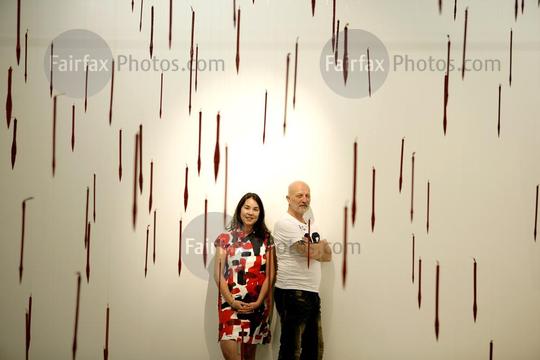Brushing Up On Asian Art
A new gallery explores an often overlooked region, writes Liza Power on Sydney Morning Herald.

IF PRESSED to choose a favourite piece from the Melbourne International Fine Art gallery’s opening exhibition, curator Mikala Tai would probably opt for Fears of a Jaded Descent. It’s an installation piece by Manila-born, Sydney-based artist Vienna Parreno, and it comprises 100-odd Chinese calligraphy brushes dipped in red paint and suspended from the ceiling on lengths of fishing wire. From a distance, the brushes gleam like bloodied darts, somehow paused in their feverish hail towards the ground.
Parreno found the brushes in a grocery store in downtown Beijing. The 32-year-old says it’s a city ”overflowing with over a million people trying to make a living from paintings, sculptures, photographs, installations and good luck”.
But just as Parreno’s work neatly encapsulates the dreams of China’s current wave of aspiring artists, it also reflects the philosophy underpinning the new Melbourne gallery space in which it hangs.
Located in an unlikely first-floor nook above Collins Street, between Elizabeth and Swanston, MiFA’s aim is to introduce Melburnians to emerging and established artists from the Asia-Pacific region. Its launch exhibition, Asia Now, is precisely that: a tantalising collection of works from China, Indonesia, Korea, Japan, Vietnam, Malaysia and India.
Among its stable are familiar names – the NGV hosted an exhibition of works by Vietnamese-Australian artist Kim Hoa Tram in 2008, and celebrated Chinese photographer Quentin Shih’s most recent exhibition, presented by Christian Dior, was a hit in America – and some less so, such as Melbourne photographer Pia Johnson and Parreno.
For Tai, who will co-direct the space with Melbourne gallery scene stalwart Bryan Collie, MiFA offers a chance to turn her great love into a vocation. Born to a Chinese father, she grew up in Hong Kong, returning to Melbourne frequently. Her aunt worked with Collie at the Melbourne Art Exchange in the 1980s; Tai recalls babysitting her cousins while the two hung paintings. When Tai returned to Australia to begin university (she’s now part-way through a PhD in art history), she gravitated towards art that resonated with her own exploration of identity from a cross-cultural perspective.
She and Collie, who has been travelling and buying art in Asia since the 1980s, began discussing gallery ideas some years ago. Researching the Melbourne gallery scene, Tai saw an opening. ”When I began looking, it became obvious there weren’t any commercial galleries showing contemporary Asia-Pacific art,” she says. ”If you wanted to buy art from emerging Korean or Indonesian artists, I wouldn’t know where to send you.”
Despite this, Tai feels Australians are increasingly curious about Asia-Pacific art. ”There’s a lot of interest in the stories that are coming out of the region. There’s been a radical shift in our relationship with it, too.”
Tai’s PhD research focuses on ideas of artistic independence in contemporary Chinese art. While political freedom is part of this focus, it’s not, she says, as pivotal as people imagine. ”Outsiders might see China as a place of curbed expression and limited internet access, but compared to their parents, young Chinese artists enjoy tremendous freedom. Also, the Chinese government is slowly realising in its race to become this global, economic super power that it needs to have a cultural base as well … so it’s beginning to support artists in a way it hasn’t before.”
Beijing’s flourishing arts scene has given rise to a wave of practitioners who meld traditional methods and contemporary approaches in fascinating ways. Yang Yongliang, for example, combines calligraphy and ancient Song Dynasty painting styles with photographs of modern streetscapes, in turn creating beguiling explorations of modern Chinese identity.
”Yang is one of the few artists of this new generation who look backwards and forwards simultaneously,” says Tai. ”He’s not still mulling over the cultural revolution. Young artists rarely do, because those stories from the past are not theirs to tell.”
Much of the work at MiFA will stem from friendships Tai has forged while in China for her studies. Other works – such as The Storm at Bali by Indonesian expressionist Affandi, and Aggregation, crafted from triangles of folded Mulberry paper by Korean artist Chun Kwang Young – are ”wish list” pieces Tai and Collie hope will set the tone for the gallery as it finds its feet.
Either way, Tai hopes never to become the kind of ”helicopter curator” who flies in and out of a country solely to collect canvases. ”Because having your story told by someone who’s not connected to it in any way really defeats the purpose of opening a gallery and being passionate about art.”
MiFA opens on Thursday, Level 1, 278 Collins Street, city. mifa.com.au